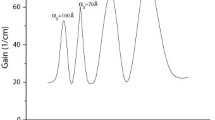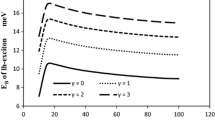Abstract
Oscillator strength and absorption cross-section of core-shell triangular quantum wire is computed for intersubband optical transition between ground state and first excited state. Kane type band nonparabolicity of first order is considered to study the shift of cross-section peak with incident radiation, and also of the oscillator strength with structural parameters. Results are compared with that obtained from parabolic overestimation. Results show that both oscillator strength and peak magnitude of absorption cross-section decreases with increasing dimension, and the rate is significant when nonparabolic dispersion relation is taken into account. Findings are important for designing optical emitter/detector using core-shell triangular quantum wire.
Access provided by Autonomous University of Puebla. Download conference paper PDF
Similar content being viewed by others
Keywords
These keywords were added by machine and not by the authors. This process is experimental and the keywords may be updated as the learning algorithm improves.
1 Introduction
Electronic and photonic properties of semiconductor quantum structures have attracted the interest of both theoretical and experimental researchers in the last few years, precisely due to the rapid growth of fabrication procedure of lower dimension devices. Quantum well, wire and dot are the prime candidates among nanostructures, where carrier motion can be confined along one, two or three dimensions, leading to quantized energy states. Different geometrical shapes [1, 2] and material compositions [3, 4] are already implemented to design semiconductor quantum heterostructures for various applications like resonant tunneling diode [5], quantum cascade laser [6], transistor [7], optical emitter [8, 9], optical detector [10], resonator [11], memory element [12] etc. Application-specific use of nanostructures requires precise computation of energy states, and thus choice of numerical method plays a key role to evaluate eigen energies for different devices [13, 14]. Recently, core-shell structure becomes an important candidate due to its inherent advantage of wider tuning range of emission/absorption spectra [15], higher absorption cross-section [16]. These structures have also improved oscillator strength compared to conventional quantum dot structures [17], which determines the probability of optical transitions between any two subbands [18]. Hence investigation of oscillator strength and absorption cross-section becomes very important for use of the heterostructure in photonic applications.
Oscillator strength of T-shaped quantum wire is computed for different material parameters [19], and also for self-assembly quantum dots [20] in presence of electric field. It is also computed for cylindrical quantum wire for field induced transition [21], and different potential configuration [22] Holovatsky [23] calculated it for elliptic nanotube and spherical dot [24]. In the present paper, authors computed oscillator strength for core-shell quantum wire of triangular geometry for the optical transition between ground and first excited states, and corresponding absorption cross-section is evaluated. InAs/Ga0.47In0.53As is the material composition considered for simulation along with the incorporation of first-order band nonparabolicity of Kane-type, and simulated result is compared with that obtained for parabolic dispersion relation with similar geometrical dimensions and material composition. The parabolic assumption is nothing but an oversimplified mathematical consideration. Structural parameters are varied to observe the change of the parameters along with a wider range of incident radiation, and peak of the cross-section is also measured. Results are important to understand the probability of optical transitions in the structure, which plays key role in determining its candidature for optical transmitter/detector application.
2 Mathematical Modeling
We consider the schematic structure of triangular core-shell quantum wire as shown in Fig. 78.1, where electrons are confined in z and y directions.
The time-independent Schrödinger equation considering Kane-type nonparabolicity of first-order for wavefunction ψ in y–z plane in Cartesian system can be written as
where γ is the coefficient of band nonparabolicity . Introducing finite difference technique, (78.1) can be written as
where i(j) is the no. of points along z(y) axis, and Δz(Δy) is dimension of the smallest grid along z(y) direction. Solution of (78.2) gives eigenstates, from which intersubband energies (ΔE j,i , which denotes the intersubband transition energy form ith state to jth state) can be estimated. The efficiency of transition is determined by the parameter oscillator strength, which is given by
where we assume the transition form quantum level ‘i’ to quantum level ‘j’. Absorption cross-section can be computed from the knowledge of oscillator strength as
where ‘n’ is the refractive index of the core material, and ‘T’ is the relaxation time. Peak absorption cross-section si given by
3 Results and Discussions
Using (78.3), oscillator strength of the structure is computed and plotted with width and length of the core region for the optical transition between ground state (E111) and next higher excited state (E112). In Fig. 78.2, it is observed that with increase of dimension for core layer, oscillator strength monotonically decreases, whereas the rate is almost negligible when parabolic dispersion relation is considered. This is due to the fact that for nonparabolic band structure, the dipole matrix element decreases rapidly whereas for parabolic band, transition energy decreases at a faster rate. But the matrix element is related with oscillator strength with square form, and hence the rate of change for the former is comparatively higher. Also with increase of core layer width, quantum confinement decreases, which causes reduction of eigenenergies, hence oscillator strength decreases.
In Fig. 78.3, absorption cross-section is plotted with incident radiation for two different core layer dimensions considering both types of dispersion relations. From the plot, it may be observed that with increase of dimension of either core width or height, cross-section peak appears at lower magnitude of incident radiation. The shift of peak position is larger for parabolic band compared to the nonparabolic one. As cross-section attains the peak corresponding to the transition energy between the two quantum levels, so the peak appears at the higher transition energy for lower width (/height) and goes to the lower value with increase of thickness. Again, since the transition energy increases due to nonparabolicity, so the peak appears at lower magnitude of incident radiation. But the shift of transition energy is very small with change of layer thickness in either of the quantized direction, so the shift of cross-section is almost negligible when nonparabolic dispersion relation is taking into account.
In Fig. 78.4, peak position of absorption cross-section is plotted with core layer dimensions. From the plot, it may be observed that with increase of width (/height), cross-section peak decreases. This is because higher core dimension decreases quantum confinement, which reduces energy. This effectively reduces oscillator strength . Since peak of the cross-section is directly proportional to oscillator strength, so peak magnitude reduces in a similar fashion to the oscillator strength. The rate is higher for nonparabolic band structure, and is almost negligible for parabolic overestimation.
4 Conclusion
Oscillator strength and absorption cross-section of core-shell triangular quantum wire is computed as function of structural parameters and with incident radiation. Band nonparabolicity of first order is considered for near accurate result. Computation reveals that oscillator strength rapidly decreases with dimension of the wire for nonparabolic semiconductor, whereas it remains almost constant when simplified parabolic band structure is considered. Hence it significantly depends on the bandgap of the material. Peak of absorption cross-section appears when incident radiation numerically equals to the intersubband transition energy, and magnitude of peak decreases with increasing dimension. Peak magnitude is higher for nonparabolic band structure. Result suggests that absorption is highly selective in core-shell structure as the cross-section profile may nearly be approximated to the Dirac-delta function.
References
Kim DH, You JH, Kim JH, Yoo KH, Kim TW (2012) Electronic structures and carrier distributions of T-Shaped AlxGa1−xAs/AlyGa1−yAs quantum wires fabricated by a cleaved-edge overgrowth method. J Nanosci Nanotechnol 12:5687–5690
Khordad R (2012) Quantum wire with parallelogram cross-section: optical properties. J Theor Appl Phys 6(19):1–7
Wong BM, Leomnard F, Li Q, Wang GT (2011) Nanoscale effects on heterojunction electron gases in GaN/AlGaN core/shell nanowires. Nano Lett 11:3074–3079
Jia G, Wang Y, Gong L, Yao J (2011) Heterostructure type transformation of ternary ZnTexSe1−x/ZnSe core-shell quantum dots. Digit J Nanomater Biostruct 6:43–53
Joel D, Singh MR (2010) Resonant tunneling in photonic double quantum well heterostructures. Nanoscale Res Lett 5:484–488
Allen SS, Richardson SL (1994) Theoretical investigations of resonant tunneling in asymmetric multibarrier semiconductor heterostructures in an applied constant electric field. Phys Rev B 50:11693–11700
Urban D, Braun M, König J (2007) Theory of a magnetically controlled quantum-dot spin transistor. Phys Rev B 76:125306
Qian F, Gradecak S, Li Y, Wen CY, Lieber CM (2005) Core/Multishell nanowire heterostructures as multicolor, high-efficiency light-emitting diodes. Nano Lett 5:2287–2291
Zhang JP, Chu DY, Wu SL, Ho ST, Bi WG, Tu CW, Tiberio RC (1995) Photonic-wire laser. Phys Rev Lett 75:2678–2681
Park BH, Baek SD, Kim JY, Bae J, Han H, Kwon O (2002) Optical sensing by using photonic quantum ring lasers and resonance-enhanced photodetectors. Opt Eng 41:1339–1345
Majumdar A, Manquest N, Faraon A, Vuckovic J (2010) Theory of electro-optic modulation via a quantum dot coupled to a nano-resonator. Optic Express 18(5):3974
Ivanov MV, Schmelcher P (2006) Electronic transmission through a coupled quantum dot and ring. J Phys Condens Matter 18:2963–2976
Ogawa M, Kunimasa T, Ito T, Miyoshi T (1998) Finite-Element analysis of quantum wires with arbitrary cross sections. J Appl Phys 84:3242–3249
Gangopadhyay S, Nag BR (1997) Energy levels in finite barrier triangular and arrowhead-shaped quantum wires. J Appl Phys 81:7885–7889
Balet LP, Ivanov SA, Priyatinski A, Achermann M, Kilmov VI (2004) Inverted core/shell nanocrystals continuously tunable between Type-I and Type-II localization regimes. Nano Lett 4:1485–1488
Nanda J, Ivanov SA, Htoon H, Bezel I, Piryatinski A, Tretiak S, Kilmov VI (2006) Absorption cross sections and Auger Recombination lifetimes in inverted core-shell nanocrystals: implications for lasing performance. J Appl Phys 99:034309
Bhattacharyya S, Das NR (2012) Effect of electric field on the oscillator strength and cross-section for intersubband transition in a semiconductor quantum ring. Phys Scr 85:045708
Yariv A (1975) Quantum electronics. Wiley, New York
Szymanska MH, Littlewood PB, Needs RJ (2001) Excitons in T-shaped quantum wires. Phys Rev B 63:205317
Bloom AR, Mirin RP, Silverman KL (2008) Reducing the oscillator strength in semiconductor quantum dots with a lateral electric field. In: Conference on lasers and electro-optics, San Jose
Wu S, Tomic S (2012) Exciton states and oscillator strengths in a cylindrical quantum wire with finite potential under transverse electric field. J Appl Phys 112(3):033715
Tshipa M (2014) Oscillator strength for optical transitions in a cylindrical quantum wire with an inverse parabolic confining electric potential. Indian J Phys 88(8):849–853
Holovatsky VA, Voitsekhivska OM, Gutsul VI (2008) Optical oscillator strengths for the electron quantum transitions in elliptic nanotubes. Rom J Phys 53(7–8):833–840
Holovatsky VA, Bernik I, Voitsekhivska OM (2014) Oscillator strengths of quantum transitions in spherical quantum dot GaAs/AlxGa1−xAs/GaAs/AlxGa1−xAs with on-center donor impurity. Acta Phys Pol A 125(1):93–97
Author information
Authors and Affiliations
Corresponding author
Editor information
Editors and Affiliations
Rights and permissions
Copyright information
© 2015 Springer India
About this paper
Cite this paper
Deyasi, A., Das, N.R. (2015). Oscillator Strength and Absorption Cross-section of Core-Shell Triangular Quantum Wire for Intersubband Transition. In: Lakshminarayanan, V., Bhattacharya, I. (eds) Advances in Optical Science and Engineering. Springer Proceedings in Physics, vol 166. Springer, New Delhi. https://doi.org/10.1007/978-81-322-2367-2_78
Download citation
DOI: https://doi.org/10.1007/978-81-322-2367-2_78
Published:
Publisher Name: Springer, New Delhi
Print ISBN: 978-81-322-2366-5
Online ISBN: 978-81-322-2367-2
eBook Packages: Physics and AstronomyPhysics and Astronomy (R0)








